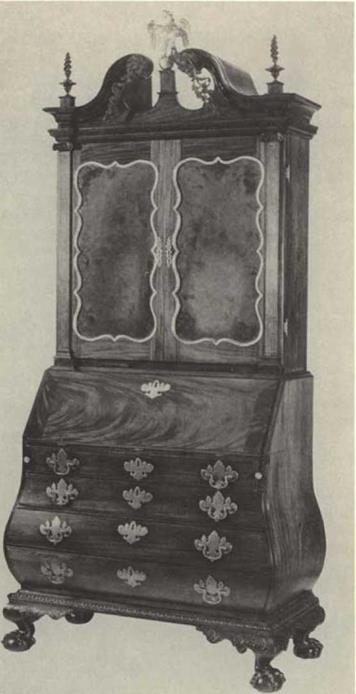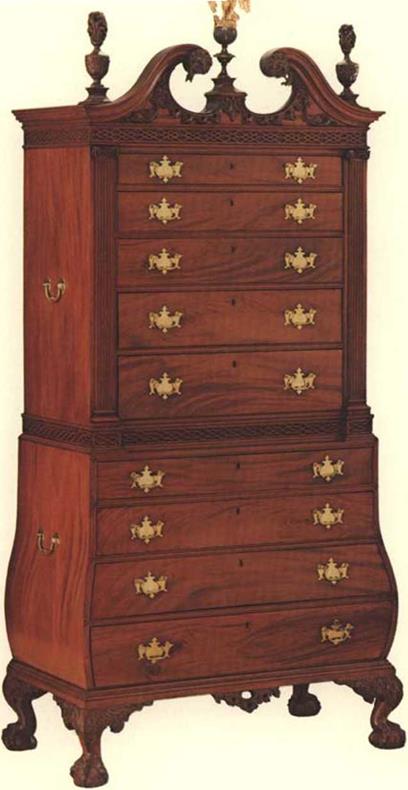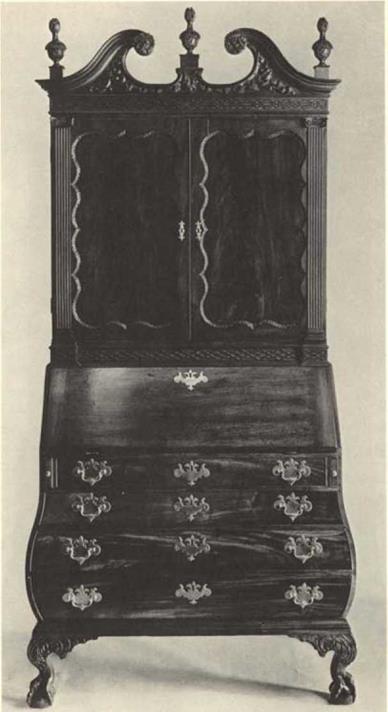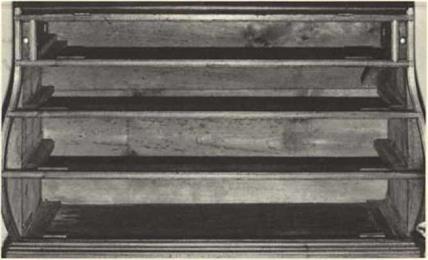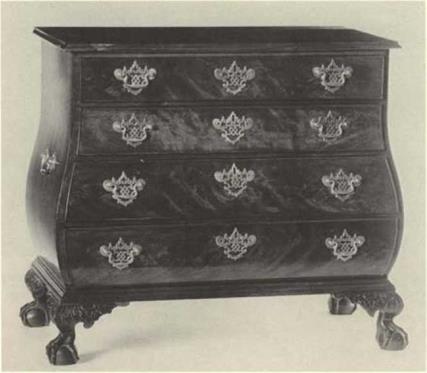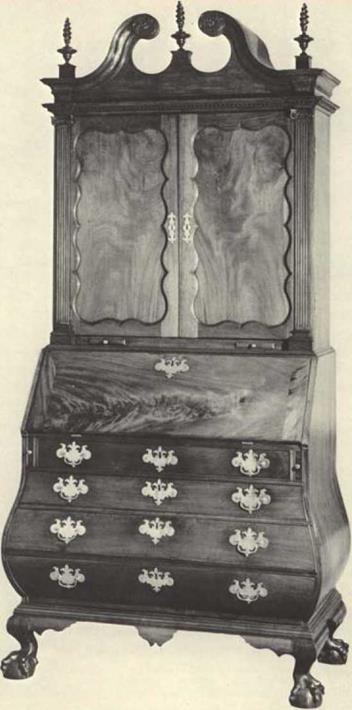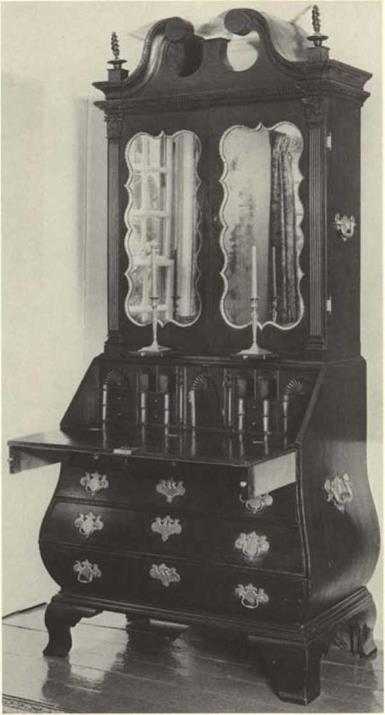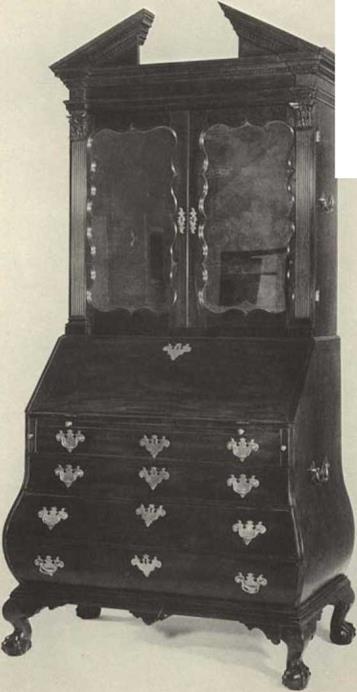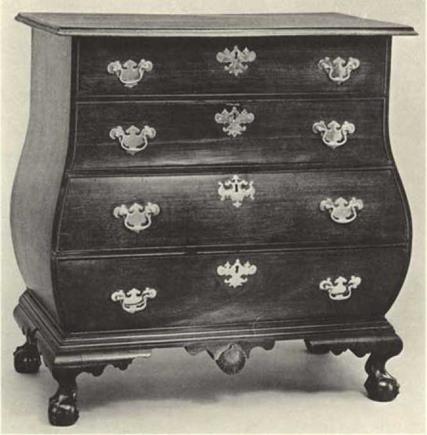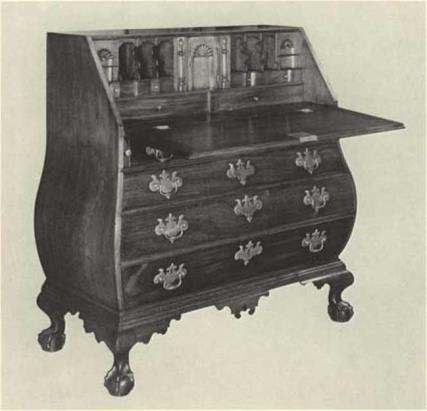The makers of only four pieces of boston bombe furniture have been identified. Л desk and bookcase, signed by Benjamin Frothing ham and dated 1753, is the earliest documented example of the bombe form in Boston (fig. 97). An unusual bomb£ desk and bookcase widi paw feet and a squatty upper section is bbclled by James Mc – M і Ilian of Boston and was made sometime before 1769 (fig. 101). Another desk and bookcase is signed by Cicorge Bright, a cabinetmaker of Boston, and was constructed sometime between 1770 and 1792 (fig, 124). A chcst-on-chcst, signed by John Cogswell and dated 1782, is the latest documented example in Boston (fig. i2j).
An outstanding example of the bombe casepiece with curved drawer sides is the desk and bookcase made by George Bright for the Boston merchant Samuel Barrett (figs. 124 and 140). Horn in Boston in 1726 and trained by his father, Bright was one of die most successful cabinetmakers in late eighteenth-century Boston,2t> His extensive patronage included such important merchants as Thomas Hancock and Caleb Davis, hi 1797 he supplied thirty chairs to the new Massachusetts State House,31 The superb quality of craftsmanship evident in die desk and bookcase directly illustrates the reason behind Bright’s immensely successful career, tn effect, the desk is truly a Boston creation in all aspects of cabinetmaking, carving, and construction. The bomb£ shape, short cabriole legs, continuous ogee panels, and swan $ neck pediment create a unity of curvilinear design. Although a massive piece of furniture, the desk is carefully proportioned in the relationship between the lower or desk section and the upper or
10. Ethel Hill Bjcrltoe, TV Cubrnr^ruftfri <y Amtrita (GarJen Ciiy, New York. 19S7). |>. 49.
11. Mabel M – Swan, "floston’i Carvert and Joimen, Part n, Pojt-Hc™lutinnjry, t’ Anliqutl, UD (April, Кцї). 1*1-184’ Richard H. Randall, Jt„ "Gcmge Bright, Cabinei maker," TV Ач Quartfrly, XX vu (19*4), 134-49-
|
|
134. Desk jtSD Bookcase. Made by George Bright, Boston, c. 1770-174)2. Mahogany and white pine; H. 99% inches, W. vjj inches, T>. za inches. (Museum of fine Arts, Boston, Bequest of Miss Clurlotte Hazeti, 461154.) See also fig. 140. According to family ГтоЛИоЛ, Sarmirl Barrett, 11 Волгин merchant, preitnted this dffk to
Ait daughter Arm pn turf marriage to /Jam Green in V}S)i,
bookcase section. Much of the detail is composed with respect to the desk or to the bookcase, but the heavy carved feet and double entablature unite the object into a carefully balanced whole. The finely carved garlands in the pediment and the egg and dart molding on the base arc examples of elaboration found only on the very finest Boston fumiture.
Samuel Barrett, the original owner of the Bright desk and bookcase. was bom in 1738. the son of the Boston merchant John Barrett. His first wife was Mary Clarke, daughter of one of Boston’s richest citizens and the sister of Sukey Clarke, wife oi John Singleton Copley, Barrett married his second wife, Elizabeth Salisbury, in 1771; the desk and bookcase is said to have been a wedding present to their daughter Ann when she married Isaac Green in 1732. The desk is signed by George Bright but is not dated – Whether it was made in 1792 as a wedding present or whether it wras an inheritance, the desk is an example of the fully developed Chippendale style.
John Cogswell was another Boston cabinetmaker who produced bomb£ furniture of the highest quality. Bom in Ipswich in 1738, he marned Abigail Goodwin of Boston in 1762 and established his residence in or near the city at that time. He was working as a cabinetmaker in Boston in 1769, when lie rendered a bill to Caleb Davis, merchant of В os ton Cogswell rose to a certain amount of
prominence and held town offices from 1778 to 1809. The identification of his cabinetwork is based upon a chest-OTt-chcst signed “Made By John / Cogswell in nudle Street / Boston 1782” (figs. 125,139, and 143), Ordered by Elias Hasket Derby of Salem, the chcst-otidiest, rhr first of five made for the Derby family, was probably intended for the new house “by the Wharf" which was dien under construction but was later abandoned just before completion,2J A desk and bookcase (fig. i2d) neither signed nor supporting a provenance has been attributed to Cogswell because of the close similarity
22. M. Adj Young, "five Secretaries mid the Cogswells” Antiques, ixxxvm (October, 1965), 484-485.
23. Joseph Dmvaa, "John Cogfwdl, Cabinet maker,” Antiques, lxi (April, 1952),
l4
125. Cuf. st-on-Chist. Marie by John Cogswell, Boston, 17B2, Mahogany and white pine; и, 97 inches, w. 44% inches, D, aj% inches. (Museum of Fine Am, Boston, William Francis Warder Fund, 1973,289.) See also figs, 139 and 143. According to family tradition, CogiwcU constructed this chest for Elios Hasla-t Derby (17751-1799) of Salem.
|
|
|
|
126. Піяі and Bookcase. Attributed to John Cogswell, Boston. e. 17701790. Mahogany and white pine; n, 95% inches, w. +J’/a indict, n. zj% indns. (The Henry brands Ju Pam Winterthur Mnieum. J Sec also fig. 127.
|
127. Interior of Desk and Bookcase. Attributed to John Cogswell. (The Henry Franps do Font Wihtertliur Museum.) See also fig. ий. |
in construction and design with the chcst-on-chest. The differences are many in the carving. The pattern of the fret on the upper section i$ quite different in design though not in scale, the knee brackets have dissimilar carved designs, the fimnls are totally different, and portions of the carving on the pediment are varied in pattern.
The bombif construction of the two casepieces presents a compromise between the two major techniques of American bombe construction.24 Cogswell has maintained the traditional straight-sided drawer construction but lias employed the outward design of curvedsided drawers by allowing only the fronts of the drawers to follow the bcunbtf bulge of the sides (fig. 127). The construction ot these
M- Twd heavily restored sctretahei with structural features similar to the Cogswell casepictcs are now in the Winterthur Museum. Both secretaries have unusual upper icctinm. much diflerrnt in appearance From the documented Cogswell chest. However, the structural similarities in the desk sections suggest attributions to Cogswell. See figure 1 Ji and Joseph I )nwns. Ameiitm Furniture, Queen Anne and Cbippen – dttIt PtrieJi ipi the iJniry Franrisdu Pant Winterthur Museum (New York, TSiSi), no. ІІ7.
|
126. CursT of DkSwJ-.Hs. Attributed to John Cogswell, Boston, c. 1770-1790. Mahogany and white pine; H. J41/* inches, W, 3S Vi inches, d, 24 inches, (Museum of Fine Arts, Boston, Bequest of Maria Theresa Burnham Hopkins, 37.34.) See also fig. 142. |
two cascpieccs may be viewed as Cogswell’s own, yet it must not be cops trued that Cogswell exclusively employed this individual method of construction.
A no tlie г variation jn drawer construction is seen in a bombe chest of drawers attributed to Cogswell (figs. 126 and 142), The interior of the bulge is cut away in the manner of most American bombd cascpieccs; but the sides of the drawers are slanted to fit the interior space of the bombi? bulge. This variation of the curved-sided drawer technique appears on about one-third of the bombi casepicces that
|
|
129. Dejk and Шоокслії, Attributed то Gibfcu A tit ins, Boston, c. 17701790, Mihogmy and white pine; it. 100 inch», vy. 46 inch», d. 2.1 indies. (Мнили of fmc Afis. Boston, M, and M. Karolifc Gollectinn, Jt). 1S1,] See .also fig. 1 Jo. According fit Jamil у tradition, this desk am I bookcase was wia/ otijj – iiwlly by Gibbs Atkins (ijjQ-tSob) and may hair been the “desk and bookcase" [valued at £20) listed in the inventory of his estate.
have the interior bulge hollowed out.25 It makes no difference to the outward appearance as the drawer fronts extend very slightly to fill out die curve of the side, but is probably easier to construct. All the other evidence regarding this chest of drawers is so conclusive that it can be safely attributed to Cogswell, but such changes in the method of construction arc difficult to interpret without more factual evidence. The elimination of the solid bulge in the chest of drawers may show a developing sophistication in Cogswell’s craftsmanship or the use of the solid bulge in the desk and bookcase and dlcsl-on-chcst may have been deemed necessary because of the increased weight of the upper section.
Furniture by or attributed to Cogswell portrays a refinement of outline and diminution of detail that is especially evident in the attenuation of the ionic pilasters and the compression of the bombe bulge. The robust circular curves of the Bright desk arc transformed by Cogswell into smaller cabriole legs and ovoid openings in the flattened swan’s neck pediment. The inclusion of fretwork iti die entablature and base of the bookcase adds to die sense of linear delicacy. The fully articulated carving expresses the spirit of rococo design; the carving of the fmials, unusual in Massachusetts furniture of this period, is a carefully considered balance to the carving on the feet. As with Federal period cabinetmakers. Cogswell carefully chose different colored mahogany to emphasize die various sections of the design. These pieces of furniture create the standard by which Cogswell can be judged as the creator of some of the most outstanding furniture made in late eighteenth-century America.
Although only four cabinetmakers, Bright, Cogswell. Frothing – ham, and McMillian, arc known to have signed bombe casepicccs. another cabinetmaker, (iibbs Atkins, may be considered for the list. Bom in 1739. Atkins was trained as a cabinetmaker in Boston. Because of bis loyalist sympathies, he moved to Halifax with members of his family in 177ft, returned to Boston by 1787, and died therein
iS, The Gay family desk and bookcase (fig. 1 ji), attributed 10 Gibbs Л( к ins. h*l slanted drawer sides; (he тгегілррінд drawer from І1 cut Id follow (he СІЧ1ІОЩ of the sides of the case,
|
130. Іптг. віов of Desk and Hookcase. Attributed to Gibln Atkins. (Мшит of Fine Arts, Boston. M. and M, Karotik Collection. jp. i£i.) Sec also fig. tag. |
і8об. A desk and bookcase (figs, tig and 130) that descended in hi* family has been attributed to him. This alone docs not substantiate die attribution, but a similar desk and bookcase with the tradition о Г being made by Atkins descended in the family of his brother-in-law.
Martin Gay (Fig, 131).2(1 The Gay family desk and bookcase has a history that aids in dating the popularity of the ЬотЫ form in Boston. Family tradition states that when the loyalist Martin Gay fled Boston in 1776, he took the desk with him to Halifax, Nova Scotia.27 That he would take such a cumbersome piece of furniture on board a British transport points to the relative value of such a desk, for many of the fleeing Tories took only silver and abandoned their furnishings. Gay could have left the desk writh his wife, Ruth Atkins Gay, who remained in Boston.28 When he returned in 1792, Gay brought the desk with him. In addition to the historical background, the statement that the desk was taken to Halifax establishes a construction date prior to 1776.
Another piece of furniture with a history dating its construction to before 1774 is a bombe desk and bookcase which was originally owned by William Green leaf, a wealthy merchant of Boston and New Bedford (figs. 132 and 133).29 During the preliminary hostilities of 1774, William Green leaf moved his possessions to Charlestown for storage. With the arrival of the Continental Army, the desk w as lent as one of the furnishings of the commander’s lodging, thus escaping the burning of Charlestown, The desk was moved again for
їй. Both secretaries ibo hive a strong relationship with the desk and bookcase
made by George Bright. Until the history of bath Atkins’ and Bright’s apprentice^ ships and their respective cabinetshops is determined, I am attributing the Gay and Atkins family desks to Gibbs Atkins.
27. Mabel M. Swan, 4’Furniture of the Boston Tories" xu (March*
1941}. 1*7.
St irk, Loyalist!, p. 313.
19. Another botubd drsk and Ьооксік ar the Mttmpnlitin Museum ib has i tradition of being owned by William Grrtnbfi However, СпкіїІнГі inventory (Bristol County Ucpistry of Probate, Taunton. Massachusetts, kl. 173) lists only one desk and book rise (valued at Sjj], The Metropolitan’s desk Ins no proven family history, thuug! i an extraneous letter ill tlicir hies mentions that a desk was owned by William Greenlcafand lent to George Washington when lie resided at the Vassal]’ Longfellow F Louse in Cambridge (Daniel Green leaf to William I’ope, Quincy, Massachusetts, July 1, iHlk I American Wing, Metropolitan Museum of Art]). Since the desk and bookcase at tile Wbaling Museum has a doeuiUnited history through the Oeenlnf family and since the Metropolitan’s letter of documentation is not tied directly to its desk, I feel that the Whaling Museum’s desk was probably the one owned by William Gremlcaf
|
|
131, De£* AND jJOORCAi*. AtiribulCtltoGibbi Atkihi, MostOfl, d. І770-І77Й. Mahogany and white pine; n. 100 ind№ (without center finiil), w. 47% iudi«, о. 23 V, inch». (Collccitnri of ВЬспегсг Gay: photo, Richard Check.) Attot&stgla family tradition, this Jrsk was OuntJ l)y Martin City {ijl6-t$QQi) Arid his tidjr Ruth (Adtfai) Gay, the iisbtr of Gibbs Atkins. A gilded eaglt and the lower portions of the JiniaSs, both still rn tht hands of tho present owner, UVfr mnpi’rd to fit the desk into rU eurrmt location.
|
|
132. Desk AKD Bookcase. Dos ton. c. 1770-1774. Mahogany and white pine; H. 97% inches, W. 47Vi inches, 1), 13У, inches. (Old Dartmouth Historical Society, Whaling Museum, New lied ford. Massachusetts: photo, Richard СІїсеіс.) See also fig. ijj. Aecordiag tofamily fWinYrn, this disk was /turned by William CiraiJif^(jjtzj-tStfj), a nrrthant af Boston and ‘ґіі Bedford.
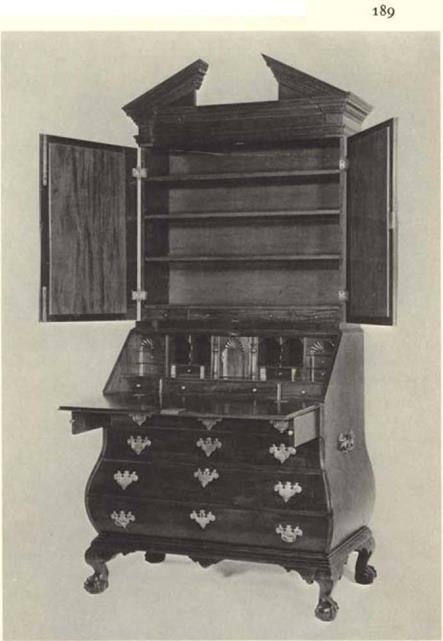
|
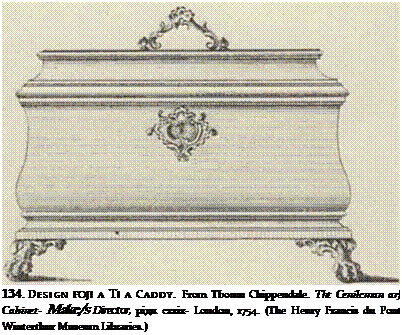
George Washington’s use at the Vassal l-Longfell о w House in Cambridge. The desk is one of the few examples of curved-sided drawer construction to date before the Revolution, A drawer in the bookcase section bears die inscription “June.. . 1771,”
Other bom be eascpicces dating before the Revolution are a desk and bookcase given to Abigail Phillips upon her marriage to Josiali Quincy, Jr., m i7>69;r,<1 a desk and bookcase belonging to Sir William Peppenrll;31 and a tea caddy copied directly from plate cxxtx in the first edition of Chippendale’s Director (fig. 134). The tea caddy
30, A partial view nf the скік and bookcase appears in in i Stos photograph of the left parlor oftheJudah Quincy Home, Quincy, Massachusetts on file in the library of the Sodety for the Preservation of New F-ngbnrt ЛінЦіїІІІЄї. hostoil, Massachusetts.
31, Side, Fine Pointf, p. 161, bottom.
|
|
135. Desk and Bookcase. Boston, c. 17*0-1795. Miiiogatiy and while pine; и. и VS inches, w. П’/я inches, D. ло’/л inches. (The ifenry Frinei} du Pont Winterthur Museum.) AtcorJing to family tradition, this Jtlit ii’ds пн’деіііу Joftplt Bamtl (jyjs-jflft/h ч ivealthy met – (hunt of Boston who «maruded ait elegant two-story Aeiw ef Lcchmert Point between vjqz 1tni 1793.
|
136. CtiKSTOF Drawp-AS. Salem, c, 1763-1790. Mahogany and while pine; 11. іпсЬсї, w, 4t> inches, d, inches, {The Henry Francis du Pont Winterthur Museum,) Sec also fig. Hi. According re family tradition, this (fast u-hj otvned by ifa Waters family of Salem during (fa late eighteenth tentury. |
has die date 1765 written in two places. With the acceptance of the bom be form well established by the rime of the Revolution, Cogswell’s ehcst-on-chest demonstrates that the form was favored by the most fashionable clientele into the 1780s. Bombc cascpieces with serpentine fronts have a reduction of detail and scale that suggest the delicacy and refinement of the neoclassical style and may well date as late as the 1790s (fig. 135).
A sixth cabinetmaker may be tentatively added to the list of men
ЇІЧ j4rtft’gn«4 Lxra (May, 195j), j. Aruithcr Ma£$jchutctt) tinmW t« caddy made
of mahogany and white pine is illustrated in Israel Sack. Inc., Opportunities in /fmrnVin Antique^ яка (November,. 1972), 43.
|
137. Chest of Dsaweb^, Salem area, e. 1761-1790, Mahogany anil white рілс; н. }7^ inches, w. 37% inch», D. zi’/j inches. (The Bayou Bend Collection of the Museum of Fine Arts, Houston.) |
known to have constructed bombe furniture. A block front desk signed by the cabinetmaker Henry Rust (figs. 84 and 85) has construction, detailing, and proportional organization similar to a group of bombe furniture (figs. 136-138), Bom in Ipswich, Rust received his training from Jonathan Gavet of Salem13 and could have been the
jj. Ванн M – Forman, "Salem Tradesmen and Craftsmen Circa 1761: A Contemporary Document,11 Eutx InsiHatt Hittotitiil Colltctims, evu (January. 1971), 81.
|
1Ж Du S К. Salem НТО. C 1765-1790. Mihogitiy and while pine, ІГ. 43 Vj inches, DP, 4J% inches, d. їот/л inches. [Museum of Fine Am, Boston, M. and M, K. iroijk Colleciton, 41-57+) |
source of the bombd furniture generally attributed to Salem, This furniture is distinguished by a finely carved and strongly realistic quahog shell on the center drop – The greatly elongated knee brackets arc shaped in a distinct pattern of two reverse curves balancing a semicircle with small breaks, A chest of drawers in the Winterthur Museum {fig, 136) has a History of descent in the Waters and Osgood families of Salem. A nearly identical chest in the Marblehead Historical Society also descended in die Osgood family. From die his – cory of ownership, stylistic connection with a Salem cabinetmaker, and the peculiarities of form and design that separate this group from other American bombe furniture, it seems likely that ease – pieces with the above characteristics are indeed a product of Salem and not Boston proper. Since Rust was working from 1762 to iSoof4 it is impossible to determine if construction predates or postdates the Derby rfiCSt-an-dlcsL[61] [62] The bombe form is obviously similar, but the Salem-attributed examples arc not constructed with hidden straight-sided drawers (fig. 121}, In addition, the so-called “quahog school” has a definite development of increasing sophistication in the design that implies a relatively uneducated first attempt. In die chest of drawers at Winterthur the bombd bulge begins abruptly after the second drawer, thus dividing the visual balance and losing the overall unity of the sides. A chest of drawers at Bayou Bend (fig, 137) incorporates the curve at the second drawer, but the curve is still too pronounced. Other examples from die same group achieve die flowing curve characteristic of the best American design (fig.

